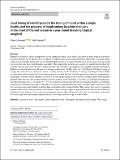Files in this item
Local timing of rainfall predicts the timing of moult within a single locality and the progress of moult among localities that vary in the onset of the wet season in a year-round breeding tropical songbird
Item metadata
| dc.contributor.author | Nwaogu, Chima Josiah | |
| dc.contributor.author | Cresswell, Will | |
| dc.date.accessioned | 2020-11-05T12:30:25Z | |
| dc.date.available | 2020-11-05T12:30:25Z | |
| dc.date.issued | 2020-10-10 | |
| dc.identifier | 270265766 | |
| dc.identifier | a424810d-768a-4efe-b24f-412c5e5b0c47 | |
| dc.identifier | 000578469300001 | |
| dc.identifier | 85092395973 | |
| dc.identifier.citation | Nwaogu , C J & Cresswell , W 2020 , ' Local timing of rainfall predicts the timing of moult within a single locality and the progress of moult among localities that vary in the onset of the wet season in a year-round breeding tropical songbird ' , Journal of Ornithology , vol. First Online . https://doi.org/10.1007/s10336-020-01825-1 | en |
| dc.identifier.issn | 2193-7192 | |
| dc.identifier.other | ORCID: /0000-0002-4684-7624/work/83085847 | |
| dc.identifier.uri | https://hdl.handle.net/10023/20905 | |
| dc.description | Funding: C.J.N. was supported by a studentship funded by the Leventis Conservation Foundation through the University of St. Andrews, UK and an Ubbo Emmius grant of the University of Groningen. | en |
| dc.description.abstract | Rainfall seasonality is likely an important cue for timing key annual cycle events like moult in birds living in seasonally arid environments, but its precise effect is difficult to establish because seasonal rainfall may affect other covarying annual events such as breeding in the same way. In central Nigeria, however, Common Bulbuls Pycnonotus barbatus moult in the wet season but only show weak breeding seasonality. This suggests that moult is more sensitive to rainfall than breeding, but a similar outcome is possible if moult is simply periodic. We tested the relationship between rainfall and moult in Common Bulbuls at a single location over 18 years: on average moult started 5th May (± 41 days: 25th March–15th June), being on average later than the onset of the rains which is usually mid-April. The likelihood of finding a moulting Common bulbul was best predicted by rainfall 9–15 weeks before moult was scored. We then tested the generality of this across populations: the progress of moult should, therefore, correlate with the average timing of the wet season along a spatial environmental gradient where the rains start at different times each year south-to-north of Nigeria. To test this, we modelled moult progress just before the rains across 15 localities 6°–13° N as a function of the onset of the wet season among localities. As predicted, moult progressed further in localities with earlier wet seasons, confirming that the onset of moult is timed to the onset of the wet season in each locality despite weak breeding seasonality in the Common Bulbul. This strategy may evolve to maintain optimal annual cycle routine in seasonal environments where breeding is prone to unpredictable local perturbations like nest predation. It may, however, be less obvious in temperate systems where all annual cycle stages are seasonally constrained, but it may help with explaining the high frequency of breeding–moult overlaps in tropical birds. | |
| dc.format.extent | 12 | |
| dc.format.extent | 1328347 | |
| dc.language.iso | eng | |
| dc.relation.ispartof | Journal of Ornithology | en |
| dc.subject | Life history traits | en |
| dc.subject | Seasonality | en |
| dc.subject | Spatio-temporal aridity | en |
| dc.subject | Geography | en |
| dc.subject | Breed-moult overlap | en |
| dc.subject | West Africa | en |
| dc.subject | GE Environmental Sciences | en |
| dc.subject | QH301 Biology | en |
| dc.subject | DAS | en |
| dc.subject.lcc | GE | en |
| dc.subject.lcc | QH301 | en |
| dc.title | Local timing of rainfall predicts the timing of moult within a single locality and the progress of moult among localities that vary in the onset of the wet season in a year-round breeding tropical songbird | en |
| dc.type | Journal article | en |
| dc.contributor.institution | University of St Andrews. School of Biology | en |
| dc.contributor.institution | University of St Andrews. Centre for Biological Diversity | en |
| dc.contributor.institution | University of St Andrews. Scottish Oceans Institute | en |
| dc.contributor.institution | University of St Andrews. Institute of Behavioural and Neural Sciences | en |
| dc.contributor.institution | University of St Andrews. St Andrews Sustainability Institute | en |
| dc.identifier.doi | 10.1007/s10336-020-01825-1 | |
| dc.description.status | Peer reviewed | en |
This item appears in the following Collection(s)
Items in the St Andrews Research Repository are protected by copyright, with all rights reserved, unless otherwise indicated.

